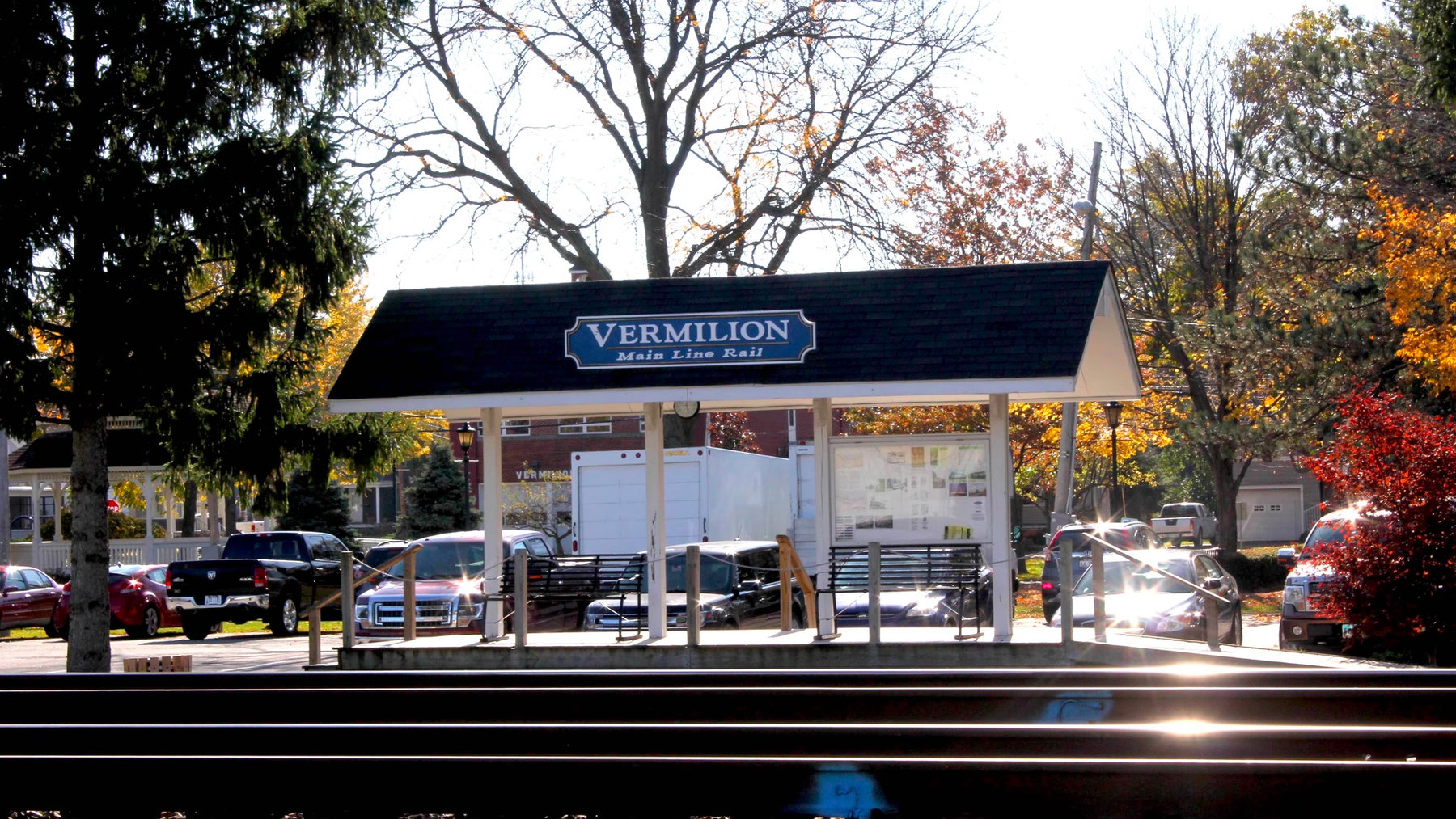It’s a question less loaded than the regional conversation-starters of Washington, D.C. (“What do you do?”), or Greenville, South Carolina (“Where do you go to church?”), or even St. Louis (“Where did you go to high school?”). And the question is more detached from implied judgment, since you can’t help where your parents lived when you were growing up.
I returned to my hometown recently, to try to have a look at it in a dispassionate way, the way we have looked at the dozens of towns we’ve visited over the past three and a half years for The Atlantic‘s American Futures project. How had my town moved through the decades of a classic declining Rust Belt experience into a new era? And how might the clear and strong imprint of the town that I remember have changed in the decades since I moved away?
* * *
Vermilion, Ohio, is the kind of small town that leaves a very strong imprint. It is 40 miles west of Cleveland, never close enough to be a suburb, and always proud enough to resist such a moniker.
 Vermilion from 2,000 feet up (Deborah Fallows)
Vermilion from 2,000 feet up (Deborah Fallows)Vermilion hugs Lake Erie, between what was, back in the day, the Ford assembly plant in Lorain and the General Motors plant in Sandusky. Many of my friends’ fathers worked in the plants, and many kids from my high school graduated and headed straight to the plants. The town doubled in size in the 1960s, from 5,000 to 10,000 people, when workers flooded north from Memphis to the auto plants. The town’s population has held steady at 10,000 since then, despite the downsizing and auto-plant closures, the Lorain steel mills, and the spin-off economy. It came as no surprise that Vermilion voted for Donald Trump in November; on the weekend before the election, we passed many signs for Trump and just a few for Clinton in people’s yards.
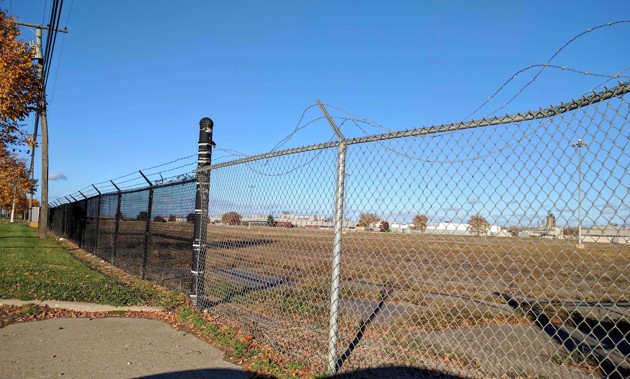 What was once the Ford plant in Lorain (Deborah Fallows)
What was once the Ford plant in Lorain (Deborah Fallows)Historically, Vermilion (one L, and named for the color of the mud along the river banks) was a fishing and farming town. It is defined by the culture of water, the lake on the north side and the river marking the edge of the old downtown before winding to the east and then south under the railroad tracks toward the farmlands.
As a kid, I could stand with a fishing rod on the dock in front of my house. When the white bass were running, they would impale themselves even on my baitless hook. Once, one six-incher jumped straight into my dinghy. When we visited again a few months ago, the commercial fishing boats were out in full force beyond the mouth of the river. The weekend fish fries in summer still turn out the town. The fire department is still all-volunteer. There is a small museum in town, chock-a-block full of paraphernalia of the town’s history. It was a sign of cultural constancy to me that the house I grew up in now has a white picket fence around its yard.
To my eye, the town has been enthusiastically adopting many of the same practices we have seen in other towns that are moving themselves forward and intentionally into the 21st century.
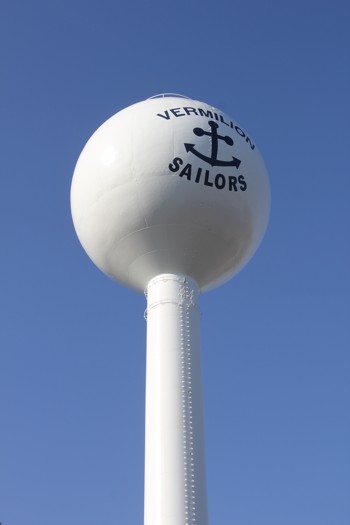 Go Sailors! (Deborah Fallows)
Go Sailors! (Deborah Fallows)Vermilion is making the most of its maritime placement and heritage. Approaching by land or by sea (or even by air as we did in our small Cirrus plane to the nearby Lorain County Airport), you readily spot the central Vermilion water tower, painted as I remember with an anchor and the word SAILORS. (Yes, that’s the proud name of the high school’s teams.) The marching band‘s summer uniforms featured middies and jaunty sailor hats; perhaps they still do. The street of the new school’s complex is named Sailorway. The children’s section of the expanded and modernized library is built around a ship theme. You can borrow fishing equipment at the Ritter Public Library. Public art and marketing materials feature water, the lighthouse, and boats.
 The ship Niagara in the Ritter Public Library (Deborah Fallows)
The ship Niagara in the Ritter Public Library (Deborah Fallows)Mayor Eileen Bulan toured us around the improvements at the downtown beach, part of a master downtown-revitalization plan. The public beach that I recall from my youth, forgotten-looking and untended, now has a wooden walkway, a tended beach, and ideas to develop outbuildings, renovate and repurpose the next-door maritime museum (which moved out of town), and beautify the abutting riverfront property, where the house of one of the town’s early families once stood. This is a welcome egalitarian and tourism step, as the usable beaches were formerly mostly private-access.
 The beach walkway, the lighthouse, and the former maritime museum (Deborah Fallows)
The beach walkway, the lighthouse, and the former maritime museum (Deborah Fallows)The river, which used to be far more utilitarian, with its big waterworks, a sewage-treatment plant, fish-processing houses, sail-making loft, and a single, ramshackle boat-in restaurant, now includes riverfront condos, river cruises for tourists, a busy boat club with popular sail programs for local kids, and more restaurants.
 The working waterfront (Deborah Fallows)
The working waterfront (Deborah Fallows)
* * *
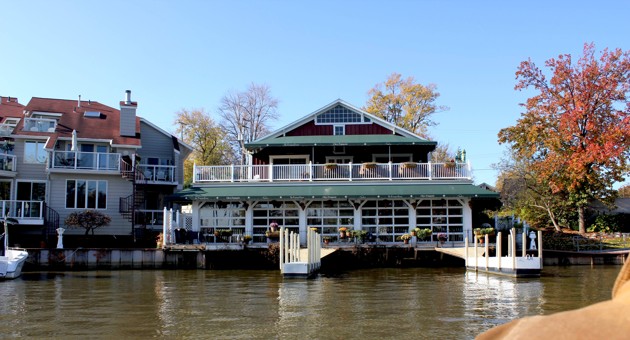 The now-famous Chez Francois restaurant, from the water (Deborah Fallows)
The now-famous Chez Francois restaurant, from the water (Deborah Fallows)Well, I was wrong to shrink. And this is Reason #25 why you should return to visit your hometown if you haven’t been there in a while. As we’ve heard said by returnees to Greenville or Fresno or Burlington or Dodge City, “You wouldn’t recognize the town anymore.”
The French restaurant, actually called Chez Francois, was just voted one of the top 100 restaurants in America for the year, from 10 million reviews of 24,000 restaurants across the country by OpenTable, the popular restaurant-reservation app. And as nice and well-earned as that honor is, there is more to it than honor for Vermilion.
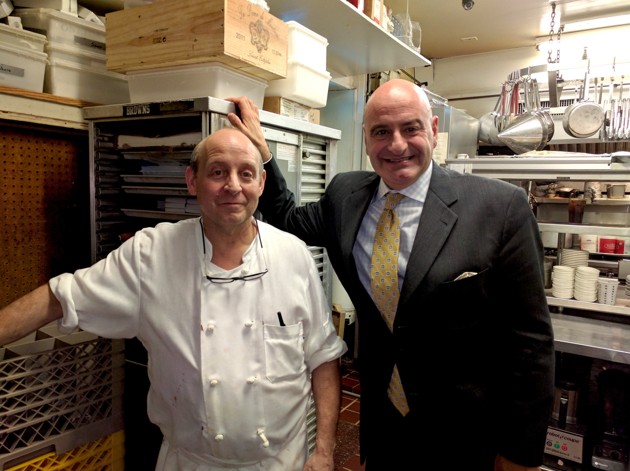 Executive chef John D’Amico, left, and proprietor Matthew Mars, of Chez Francois (Deborah Fallows)
Executive chef John D’Amico, left, and proprietor Matthew Mars, of Chez Francois (Deborah Fallows)Chez Francois was started by proprietor Matthew Mars and executive chef John D’Amico, who met as dishwasher and prep cook in an Italian restaurant in Cleveland owned by Mars’s father. They opened Chez Francois in what had originally been a sail loft and then was the site of another restaurant from the 1960s, L’Auberge du Port. It’s in prime real estate for the town, facing the river on one side and Main Street on the other. It is a terrific restaurant, and it is a key player in an economic way forward for the town.
The restaurant draws destination diners, whether from Cleveland or farther-away venues like Toledo or Columbus. They come for a special event, a not-necessarily-special event, as hungry boaters, and even regulars for a planned stop on their biannual snowbird migrations between the North and the South. More restaurants are opening in town, and the competition is welcome, Mars told us.
In a buy-local boost, Chez Francois has sourced from local farms since the late 1980s, ahead of the trend. I recognized some family names from the farm kids I knew in high school. Another source, 10 miles southwest of town is the Culinary Vegetable Institute, at The Chef’s Garden, on the site of a family farm turned progressive learning center/growing center/culinary center for everyone from professional chefs to earth-to-table aficionados.
One of the energetic drivers of the town is the all-volunteer Main Street Vermilion project, the backbone of the town’s historic preservation and business development. Its parent group, Heritage Ohio, runs the state’s official historic preservation and Main Street efforts and is part of a broad nationwide Main Street movement. We’ve seen local Main Street projects transforming downtowns across the country.
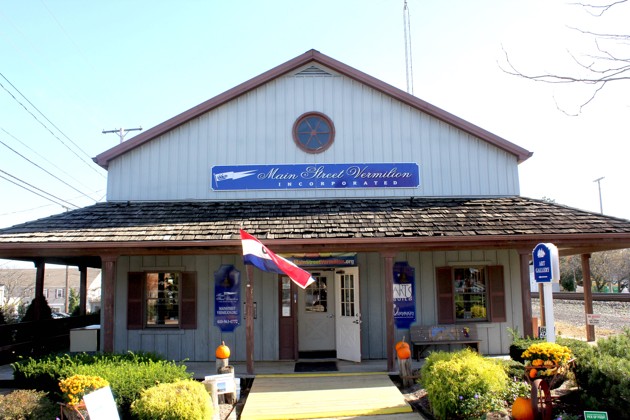 Main Street Vermilion’s office (Deborah Fallows)
Main Street Vermilion’s office (Deborah Fallows)Main Street Vermilion organizes or promotes an astounding, relentless, creative stream of events, from parades and festivals to arts fairs and public-arts displays, plus triathlons, the lighthouse restoration, farmers’ markets, flower beautification, holiday lights, and outdoor movie and concert nights (like Third Thursday and Concerts in the Park, organized by the Vermilion Chamber of Commerce).* It put together a self-guided walking tour of the homes of 28 ship captains who lived in Vermilion in its shipbuilding heyday from the 1830s until the early 20th century.
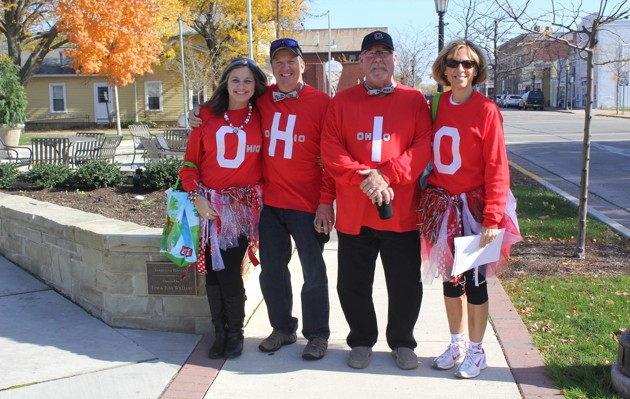 Buckeye Proud! A family of Ohio State fans get ready for that afternoon’s Ohio-Nebraska game. The Buckeyes eked out a win over the Cornhuskers, 62-3. (Deborah Fallows.)
Buckeye Proud! A family of Ohio State fans get ready for that afternoon’s Ohio-Nebraska game. The Buckeyes eked out a win over the Cornhuskers, 62-3. (Deborah Fallows.)On a Saturday in early November, the Ohio State Buckeyes were taking on the Nebraska Cornhuskers. Never mind that the game was in Columbus, some 120 miles to the south. In Vermilion that pleasantly warm, sunny day, crowds of football fans were gathering for beer and tailgate food on Liberty Street, strolling and popping in and out of shops and galleries. They turned the town from sleepy to bustling and represented an important part of its future hopes.

